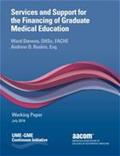UME-GME Continuum
Check out the UME-GME Digital Resource Library to view events and other resources for faculty development in GME.
In May 2017, AACOM announced the establishment of a new task force that is strategically examining and responding to changes in the healthcare system and in medical education that may impact osteopathic medical education (OME). The task force considers the current environment, formulates strategy, and executes initiatives related to clinical training throughout the continuum of OME. Issue-based sub-groups led by task force members have been created and continue to engage experts and thought leaders in medical education.
This three-year effort is led by a 14-member steering committee, chaired by John Kauffman, DO, Dean & Chief Academic Officer, Campbell University School of Osteopathic Medicine (CUSOM) and AACOM Board Member. Five issue-based working groups have been established to support the efforts of the steering committee. The five sub-groups include: Supporting Residency Programs through the Single GME Accreditation Process, Faculty Development for Programs with Osteopathic Recognition, Models for Clinical Education Collaborations of the Future, Preparing for the Single Residency Match, and Scholarship & Research.About the UME-GME Continuum Initiative
Clinical Education Working Group Paper II
The Osteopathic Learning Environment
Author: Robert Cain, DO
This working paper, The Osteopathic Learning Environment, features the work of AACOM's Models for Clinical Education Collaborations of the Future Working Group, a seven-member working group of leaders in osteopathic clinical medical education that was developed to formulate recommendations for collaborative models of clinical education that can provide support and services to foster a strong learning environment across the continuum of undergraduate medical education (UME) and graduate medical education (GME).
This paper provides background on the osteopathic learning environment (OLE) and presents an overview of the importance of the OLE for the osteopathic profession. It provides a detailed summary of the characteristics of the OLE, and it concludes with the role of collaboration within osteopathic graduate medical education (OGME) in achieving an optimal learning environment.
Scholarship & Research
This working group focuses on supporting scholarship and research in residency programs to help meet accreditation requirements and also focuses on ways to enhance the culture of inquiry throughout the continuum of osteopathic medical education.
Learn More
Faculty Development for Programs with Osteopathic Recognition
This working group focuses on understanding the challenges and opportunities for faculty development in graduate medical education, specifically for programs with or seeking Osteopathic Recognition. Development of effective training and assessment resources for different faculty specialties to foster, maintain, and enhance ongoing education in the integration of Osteopathic Principles and Practice and the osteopathic competencies is a focus of this working group.
Learn More
Supporting Programs in the Single GME Accreditation System
This working group focuses on helping to ensure American Osteopathic Association (AOA)-approved programs successfully transition to Accreditation Council for Graduate Medical Education (ACGME) accreditation within the three-year time frame (by June 30, 2020) and that a significant percentage of formerly AOA-approved programs and ACGME-accredited programs attain Osteopathic Recognition.
Learn More
Search the Undergraduate Medical Education-Graduate Medical Education (UME-GME) Digital Resource Library to view events and other resources for faculty development in GME.
Future Models of Clinical Education Collaborations
This working group develops recommendations for collaborative models of clinical education that can provide support and services to foster a strong learning environment across the continuum of undergraduate medical education (UME) and graduate medical education (GME).
Learn More
Preparing for the Single Residency Match
This working group focuses on the awareness and education of students, colleges of osteopathic medicine (COMs), and residency programs on the single residency match.
Learn More
Clinical Education Working Group Paper I
The Value of Collaboration for the Osteopathic Medical Education Clinical Learning Environment
Authors: John Kauffman, DO, Thomas Boyle, DO, and Stephen C. Shannon, DO, MPH
This working paper, The Value of Collaboration for the Osteopathic Medical Education Clinical Learning Environment, features the work of AACOM's Models for Clinical Education Collaborations of the Future Working Group, a seven-member working group of leaders in osteopathic clinical medical education that was developed to formulate recommendations for collaborative models of clinical education that can provide support and services to foster a strong learning environment across the continuum of undergraduate medical education (UME) and graduate medical education (GME).
This paper begins with an overview of the osteopathic medical profession and a brief summary of the history of osteopathic graduate medical education (OGME). It then provides a historical summary of osteopathic GME consortia, including that of Osteopathic Postdoctoral Training Institutes (OPTIs), and a scope of the benefits that these consortia have provided to OGME. This paper closes with the impact of the single GME accreditation system on OGME and the importance of retaining osteopathic distinctiveness throughout the transition to this system.
Services and Support for the Financing of Graduate Medical Education
Authors: Ward Stevens, DHSc, FACHE, Andrew D. Ruskin, Esq
This working paper, Services and Support for the Financing of Graduate Medical Education, examines guidelines for selecting hospitals that can meet GME requirements, and explores the role of consortia in establshing and supporting new GME programs.

